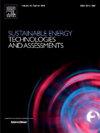Convective heat transfer coefficient for realistic turbulence parameters using LES vs. RANS turbulence models in case of free-standing photovoltaic panel
IF 7.1
2区 工程技术
Q1 ENERGY & FUELS
Sustainable Energy Technologies and Assessments
Pub Date : 2024-11-26
DOI:10.1016/j.seta.2024.104108
引用次数: 0
Abstract
The efficiency of photovoltaic (PV) and hybrid photovoltaic-thermal (PVT) solar panels partly depends on the heat transfer to the ambient air. The exact value of the convective heat transfer coefficient (HTC) is particularly important for the development of cooling techniques. The HTC values are usually determined from experimental data available for flat plates and similar geometries. Since the HTC depends on the geometrical details of the PV panel and the environment, the HTC values are usually estimated using computational fluid dynamics (CFD) based on the Reynolds-averaged Navier-Stokes equations (RANS). In this work, a free-standing PV panel is considered, and the main objective of the work is to compare the RANS results with the large eddy simulation (LES), which is expected to provide more reliable results compared to the available experimental data. The research includes the effects of inlet velocity, turbulence intensity and turbulence length scale. It was shown that the HTC depends on both turbulence intensity and turbulence length scale. The results show that RANS models significantly overestimate the influence of inlet turbulence on the HTC, by up to 70% at high inlet turbulence intensities. Meanwhile, the LES values are within 5 % of the experimental HTC values.
使用 LES 与 RANS 湍流模型计算独立式光伏板上现实湍流参数的对流传热系数
光伏(PV)和光伏-热混合(PVT)太阳能电池板的效率部分取决于向环境空气的热传递。对流传热系数(HTC)的精确值对于冷却技术的发展尤为重要。HTC 值通常是根据平板和类似几何形状的实验数据确定的。由于 HTC 取决于光伏板和环境的几何细节,因此通常使用基于雷诺平均纳维-斯托克斯方程(RANS)的计算流体动力学(CFD)来估算 HTC 值。本研究考虑的是独立式光伏板,主要目的是将 RANS 结果与大涡流模拟 (LES) 结果进行比较,预计后者与现有实验数据相比能提供更可靠的结果。研究包括入口速度、湍流强度和湍流长度尺度的影响。研究表明,HTC 取决于湍流强度和湍流长度尺度。结果表明,RANS 模型明显高估了入口湍流对 HTC 的影响,在入口湍流强度较高时,高估幅度可达 70%。同时,LES 值与实验 HTC 值的误差不超过 5%。
本文章由计算机程序翻译,如有差异,请以英文原文为准。
求助全文
约1分钟内获得全文
求助全文
来源期刊

Sustainable Energy Technologies and Assessments
Energy-Renewable Energy, Sustainability and the Environment
CiteScore
12.70
自引率
12.50%
发文量
1091
期刊介绍:
Encouraging a transition to a sustainable energy future is imperative for our world. Technologies that enable this shift in various sectors like transportation, heating, and power systems are of utmost importance. Sustainable Energy Technologies and Assessments welcomes papers focusing on a range of aspects and levels of technological advancements in energy generation and utilization. The aim is to reduce the negative environmental impact associated with energy production and consumption, spanning from laboratory experiments to real-world applications in the commercial sector.
 求助内容:
求助内容: 应助结果提醒方式:
应助结果提醒方式:


